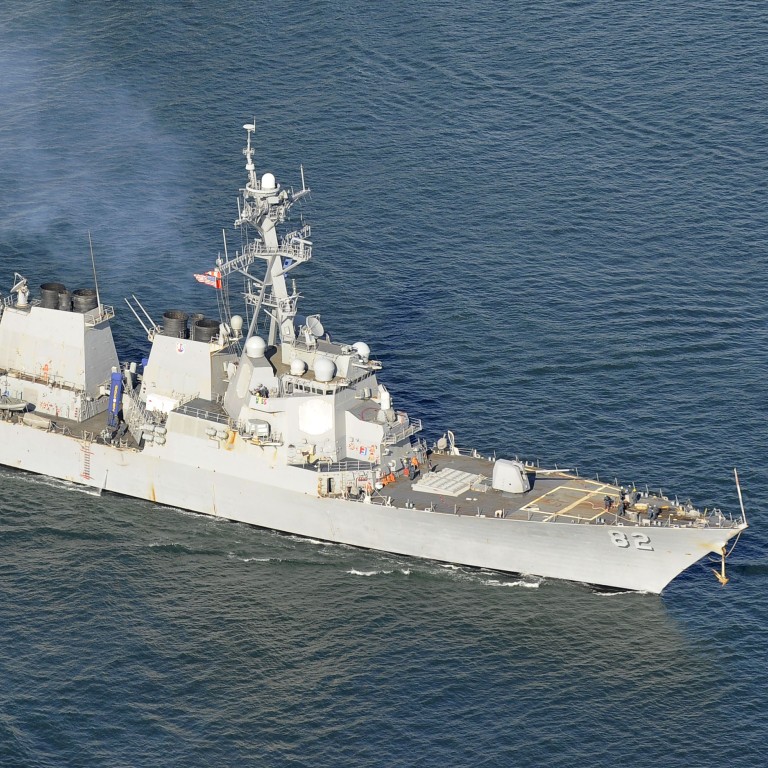
Update | War of words: Beijing fumes as US threatens to send more warships near disputed South China Sea islets
US Navy to send more vessels near artificial islands built by Beijing, says US official; 'We will fly, sail and operate wherever international law permits,' says US Defence Secretary Ash Carter
The US Navy will send more warships to sail close to artificial islands built by Beijing in the South China Sea, a US official said.
The USS Lassen guided-missile destroyer sailed within 12 nautical miles (22km) of at least one of the land formations claimed by China in the disputed Spratly Islands chain early on Tuesday (local time).
The move infuriated Beijing, which summoned the US ambassador and denounced what it called a threat to its sovereignty.
READ MORE: US ‘playing with fire’: Chinese media’s fury after warship sails near disputed South China Sea islands
"We will do it again," the US official told Agence France-Presse on Tuesday, speaking on condition of anonymity.
“We sail in international waters at a time and place of our choosing.”
Washington’s move followed months of deliberation by the administration of President Barack Obama and could raise tension in one of the world’s busiest shipping lanes and increase strains on US-China relations.
Another US defence official said the Lassen also went within the 12-nautical-mile limits of other reefs and features in the disputed sea claimed by Vietnam and US treaty ally, the Philippines.
US Defence Secretary Ash Carter, testifying to the Senate Armed Services Committee on Tuesday, initially said only that the US Navy had conducted operations in the South China Sea.
However, under questioning from lawmakers he said the USS Lassen had passed within 12 nautical miles of a Chinese artificial island.
“We will fly, sail and operate wherever international law permits and whenever our operational needs require,” Carter told the Senate.
Read more: Beijing has options if US escalates challenge to its claims in South China Sea
The officials said such “freedom-of-navigation” patrols were expected to become more frequent.
The US destroyer sailed within 12 nautical miles of Subi Reef, an artificial island built up by China in the past year.
The second US defence official said the Lassen was followed at a safe distance by a Chinese ship and no incidents were reported during the 115km passage.
“I would expect that this becomes a regular operation in the South China Sea,” the official said. “This type of operation shouldn’t be seen as provocative.”
The official said the Lassen had been followed for weeks by Chinese vessels before the patrol.
Two other US officials said there was bridge-to-bridge radio communication with the Chinese as the Lassen approached Subi Reef.
One of the officials said the Chinese did not shadow the US warship as closely when it came within 12 nautical miles of the islands claimed by the Philippines and Vietnam.
Carter told the Senate.Subi and nearby Mischief Reef were submerged at high tide before China began a dredging project to turn them into islands in 2014.
Under the UN Convention on the Law of the Sea, 12-nautical mile limits cannot be set around man-made islands built on previously submerged reefs.
The White House said Washington had made clear to Beijing, even during last month’s visit by President Xi Jinping, that the US would fly or sail anywhere that international law allowed and stressed the importance of the South China Sea for commerce.
Watch: China warns US over sea patrols in South China Sea
Asked on Tuesday about the patrol, White House spokesman Eric Schultz said he could not discuss details about military operations, but added: “Our freedom of navigation operations do not assert any specific US rights.”
US State Department spokesman John Kirby told a regular briefing that, “setting this aside, the US-China relationship is vitally important and one we want to see continue to improve and to grow for the benefit of both our countries, not to mention the region”.
A range of security experts have said Washington’s freedom-of-navigation patrols would have to be regular to be effective, given Chinese ambitions to project power deep into maritime Southeast Asia and beyond.
“By [the US] using a guided-missile destroyer, rather than smaller vessels ... they are sending a strong message,” said Ian Storey, of Singapore’s Institute of South East Asian Studies.
“They have also said, significantly, that there will be more patrols – so it really now is up to China how it will respond.”
Watch: US patrols in South China Sea not a problem: Philippine President
Philippine President Benigno Aquino, speaking to foreign correspondents in Manila, said he supported the US naval manoeuvres as an assertion of freedom of navigation and as a means to balance power in the region.
“I think expressing support for established norms of international behaviour should not be a negative for a country,” he said.
“I think everybody would welcome a balance of power anywhere in the world.”
Without identifying China by name, he said “one regional power” has been making “controversial pronouncements” that must not be left unchallenged.
Agence France-Presse, Reuters and Associated Press

.png?itok=arIb17P0)